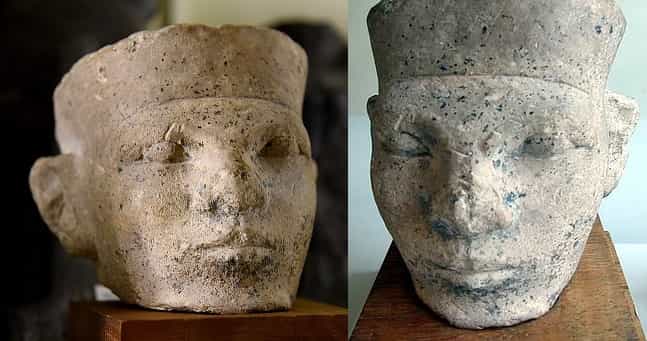Who was King Narmer?
Narmer stands as a pivotal figure in Egyptian history. He held the distinction of being the founder of Dynasty I, thereby assuming the mantle of the first pharaoh of Ancient Egypt. This significant event took place around 3050 BC, and his rule, as chronicled by sources like Herodotus and Sincelo, endured for approximately six decades.
Upon ascending to the throne of Upper Egypt, the name Menes was bestowed upon him as a regnal title. Subsequently, he expanded his dominion, eventually conquering Lower Egypt and establishing the city of Ineb Hedy, later known as “White Wall” and the future Memphis, as the seat of his governance.
The conquest of Lower Egypt was executed through force, as evidenced by the renowned Narmer Palette. The palette depicts the pharaoh wearing a crown symbolizing Upper Egypt, striking one of the depicted foreigners. Other defeated foreign adversaries are also illustrated at the base of the green shale block.
What did King Narmer achieve?
Narmer held the distinction of being the first pharaoh to consolidate and unify the Egyptian territories under his authority. The establishment of Memphis, located hundreds of kilometers north of Tinis, served as a clear demonstration of his supremacy over Lower Egypt, a conquest affirmed by the Narmer Palette.
Hailing from the city of Tinis, the capital of Upper Egypt, Narmer was wedded to Neithotep, originally from Naqada beneath Egypt, signifying that their marriage forged an alliance between both cities.
Among his notable contributions, Narmer is credited with commissioning the opulent temple of Ptah (attributed to Herodotus).
During his reign, he oversaw the construction of a dike that facilitated the drainage of the more humid region of “Ineb Hedy,” altering the course of the Nile until it flowed into a lake.
The name of Narmer is found on ceramic fragments in the delta region and even in the Levant, serving as tangible evidence of trade exchanges between these areas.
The agricultural prosperity of the delta, combined with the mineral resources of Upper Egypt, alongside the convergence of various trade routes, contributed significantly to the formation of a great empire.
King Ka, potentially the father of Narmer, is believed to have potentially reigned as King of Tinis before Narmer’s rule.
This presumption is drawn from the analysis of ceramics and other offerings discovered in his tomb, as well as the type and location of his burial in the Abydos cemetery, adjacent to the tomb associated with Narmer.
The tomb of King Narmer is thought to be situated in Umm el-Qaab, a necropolis in Abydos. It is generally believed that he was interred in tomb B17-18 within the complex, although alternative theories exist.
Historically, it is believed that the Scorpion King was among the final figures in the struggle for the unification of predynastic Egypt, and Narmer emerged as the architect of a unified empire, with Aha as his initial successor.
The name Narmer (also known as Menes) has been found inscribed in hieroglyphs on several artifacts:
- The ceremonial Mace of Narmer, located in Nekhen (Hierakonpolis).
- A baboon statue housed in the Altes Museum in Berlin.
- Cylindrical seals found in Naqada, the eastern delta of the Nile, and the southern Levant.
Interestingly, Narmer is never depicted wearing the double crown. Instead, he is alternately shown wearing either the red or white crown.
This discrepancy could suggest that the unification of territories occurred subsequent to the existence of a single ruler overseeing two separate kingdoms. It wasn’t until King Aha that the double crown signifying definitive union was successfully adopted.
The first photograph depicts the head of a king carved in limestone, potentially Narmer according to Petrie. This artifact is housed in the Petrie Museum of Egyptian Archaeology, London.

Read more: palette of narmer description







